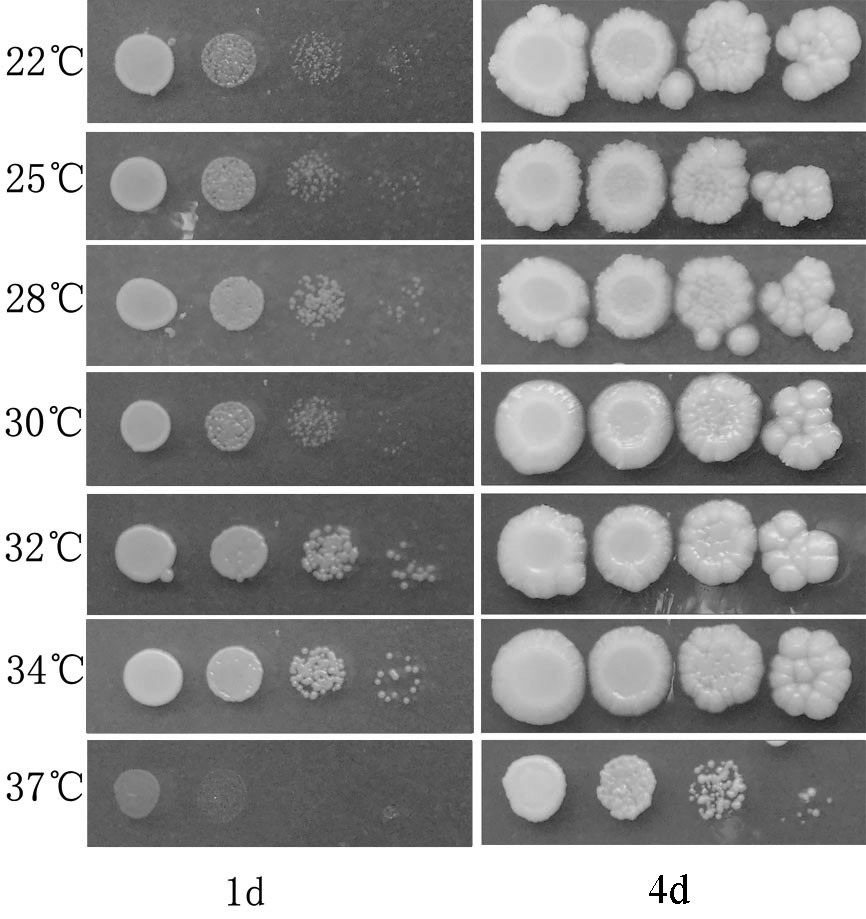Fermented pichia pastoris and application thereof
A technology of Pichia pastoris and Gibberella beading, which is applied to Pichia fermented yeast and its application field, can solve the problems of pollination difficulty, influence hybrid pollination, reduce fruit quality, etc., and achieves the improvement of pollen germination rate, promotion of pollination efficiency, Reduce the effect of falling flowers and fruit
- Summary
- Abstract
- Description
- Claims
- Application Information
AI Technical Summary
Problems solved by technology
Method used
Image
Examples
Embodiment 1
[0011] Example 1: Isolation and identification of fermenting Pichia pastoris 15B1 strain
[0012] Take fresh wild grapes, disinfect the surface with 70% alcohol, then disinfect with 50% antiformin (sodium hypochlorite solution) for half an hour, and finally soak in sterile water and rinse for 4-5 times. Cut the above-mentioned treated material on the ultra-clean bench, take the inner epidermis and inoculate it on the PDA medium (solid potato medium) plate, and when bacteria grow out, they are respectively streaked and purified, and the DNA is extracted for molecular identification , thus obtaining and confirming the strain. The specific steps for strain confirmation are as follows:
[0013] 1) Sample collection: Scrape a small amount of bacteria to be tested from the plate into a 200 μL PCR tube, add 100 μL of sterile water, centrifuge at high speed for a short time, and remove the supernatant;
[0014] 2) Sample lysis: Add glass beads with a diameter of 0.1mm-0.5mm to 50μL ...
Embodiment 2
[0020] Example 2: Morphological and biological characteristics of fermenting Pichia pastoris 15B1 strain
[0021] Use the plate dilution culture method to detect the optimal growth conditions of 15B1. Take 50 μL of the spare bacterial solution grown on the PDB medium, dilute it to 100 μL with water, and then take 10 μL of it and dilute it to 100 μL, and so on to form 4 gradient dilutions. , take 5 μL of each gradient dilution and spread it on the PDA medium plate and the LB medium plate, and compare their growth conditions. It was found that fermenting Pichia pastoris 15B1 was difficult to grow on LB medium, but grew better on PDA medium, and its optimum temperature range was 32-34°C (such as figure 1 shown), in addition, it can also grow slowly at 37 °C.
Embodiment 3
[0022] Embodiment 3: the bacteriostasis of fermenting Pichia pastoris 15B1
[0023] Pick 15B1 single clone and inoculate it in PDB medium, culture it at 32°C and 150rpm for 48h, then centrifuge at 4000rpm for 10min, filter the supernatant through a sterile filter membrane with a pore size of 0.22μm, take 0.2mL of the filtrate and evenly spread it on a PDA plate On the culture medium, an equal volume of sterile water was used as a control, and 0.5 cm of glial cell anthracnose bacteria ( Colletotrichum gloeosporioides ), Botrytis ( Botryosphaeria dothidea ) and Gibberella moniliforme ( Gibberella moniliformis) Bacterial block, the growth diameter of mycelium was measured after cultivating at 28°C for 3 days. Each treatment was repeated 3 dishes. The fungal colony diameter is measured by the cross method, and the mycelial growth inhibition rate is calculated, wherein the inhibition rate (%)=[(control fungal colony diameter-treatment fungal colony diameter) / (control fungal c...
PUM
 Login to View More
Login to View More Abstract
Description
Claims
Application Information
 Login to View More
Login to View More - R&D
- Intellectual Property
- Life Sciences
- Materials
- Tech Scout
- Unparalleled Data Quality
- Higher Quality Content
- 60% Fewer Hallucinations
Browse by: Latest US Patents, China's latest patents, Technical Efficacy Thesaurus, Application Domain, Technology Topic, Popular Technical Reports.
© 2025 PatSnap. All rights reserved.Legal|Privacy policy|Modern Slavery Act Transparency Statement|Sitemap|About US| Contact US: help@patsnap.com

